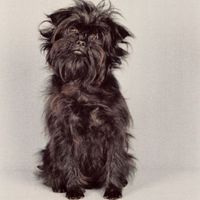
Dobermann / Dobe, Dobie, Doby

Breed history:
This breed was developed in Germany in the late 19th century by L.F. Dobermann and brought to its present-day form by another German, Otto Goller. Several crossbreedings were made starting with the German Pinscher and continuing with the Rottweiller, the English Greyhound, the Manchester Terrier and the Weimaraner, until the present variety was obtained.
Description:
It is a large-sized, sturdy, brawny and gracious dog. It has a long trapezoidal head. The skull is flat, with a long, conical muzzle and a nose that has the same color as the fur. The eyes are oval, almond-shaped and dark. The ears are usually cropped to stay erect. It has a long, muscular neck and the tail is docked short. The backline slopes slightly towards the tail. The hair is short, straight, close to the body and glossy. It can have the following colors: black, blue-gray, red, fawn and white, with rusty patches around the eyes, on the nose, neck, chest, paws and under the tail.
Personality:
It is an intelligent, very energetic, brave, alert dog, with an excellent sense of smell, with aggressive tendencies, with a lively temperament and a determined attitude. It is faithful to its family but especially devoted to one person. It is reluctant with strangers and not very patient with children. It needs to be socialized from an early age to get along well with other household animals or with other dogs.
Grooming:
This dog's fur doesn't require too much care. A rough glove can be used to remove dead hair during the shedding period. A regular antiparasitical treatment is recommended to avoid inflammations and irritations.
Living conditions:
This dog feels good outdoors having the possibility of getting a lot of exercise with an active master with a lot of experience in raising dogs. It needs socialization, training and exercise.
Training:
The Dobermann requires a person with experience in dog training. The training must be gentle but firm without being rough and should not be forced upon it from an early age. If it is not properly trained, it can become either fearful or agressive. Being a resistant, hefty dog, it needs a lot of exercise (swimming, running, and participating in various canine activities).
Usefulness:
It is an excellent watchdog, a trustworhty companion that inspires safety. It is used with good results as a guide dog for the blind, especially the females. It is also successfully used in the army or in the police.


Austrian Shorthaired Pinscher
Austrian Pinscher, Osterreichischer Kurzhaarpinscher, Österreichischer, Österreichischer Pinscher




